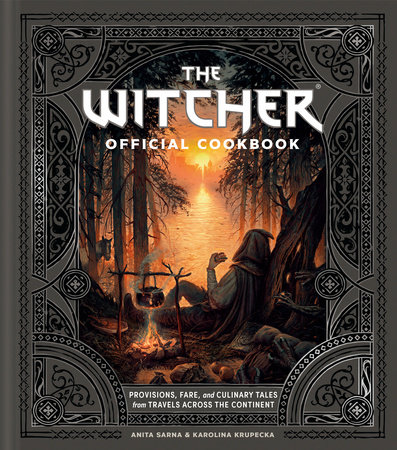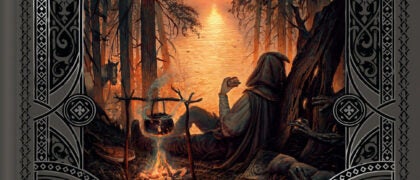IntroductionYou might not always notice the importance of food in pop culture products, but when culinary motifs are skillfully implemented in stories, they add much more than mere decoration. The finding, making, and eating of food provides relatable insight into a given world and its culture, and into the specific characters doing the finding, making, or eating. Thanks to this, universes gain layers, depth, and believability, promoting greater immersion among the audience. Culinary themes often serve as a backdrop to stories, setting the scene for plots to develop through dialogue and intrigue, or propelling the action forward through countless tavern quarrels and fight scenes during which characters use what’s at hand in combat – from cutlery, mugs, bowls, and bottles, to jars of preserve.
A large jar of cherry preserve, thought the Witcher. A jar of cherry preserve makes that noise when you throw it at somebody from a great height or with great force. He remembered it well. When he lived with Yennefer she would occasionally throw jars of preserve at him in anger. Jars she had received from clients. Yennefer had no idea how to make preserve—her magic was fallible in that respect. —Andrzej Sapkowski, “Eternal Flame”
In
The Witcher stories—whether written on the page and brought to life in the imagination or visualized on screen—one encounters a familiar yet distorted world composed of various elements drawn from European folklore and culture. Slightly twisted versions of well-known fairy tales and legends, dropped into a fantasy setting, are a hallmark of
The Witcher. These captivating reimaginings of classic stories we dimly remember from childhood form a rich background to the events and problems of the vivid, often morally ambiguous universe Geralt of Rivia explores.
In creating this book, we followed a similar path. Drawing guidance and inspiration from the books and games that have captivated us, we also looked to the folklore and customs of our proverbial backyard, blending them with unique
Witcher accents and a few new topical touches of our own. We allowed ourselves a bit of freedom due to our culinary leitmotif which we emphasized not only through accurately selected and “placed” recipes, but also with fictional stories of how our narrator learned them. We found creating these short tales, limited only by our imagination, to be both a joy and a tricky task as we had to adapt our research and inspirations in tasty, entertaining ways, all the while retaining the tone of the literary source.
To tell our stories, we needed the right guide to take you on a journey through the cookbook’s pages. Though we added a small sentimental surprise to the last chapter of the book, we deliberately let go of trying to step into a known character’s shoes, be it Geralt or Dandelion, and having them, through their prism, lead you through the narrative. We shifted the burden of the story onto another set of shoulders.
Our narrator is a new character, a cartographer from distant Kovir with a penchant for culinary exploration. She is the ideal candidate to be our guide across the Continent, traveling as a tourist with an outlander’s perspective. In this sense, she is very much like we are. Because she hasn’t been involved in any known previous events, she has the freedom to simply explore these newly visited lands and engage with their inhabitants. Though it may seem as if our narrator becomes embroiled in unusual situations rather often, we believe she credibly fits into the stylings, settings, and events of the expansive
Witcher world. For it is this world’s geographic diversity that influenced our book’s composition, divided as it is into chapters dedicated to specific regions, each chapter leading you through a given stage of the narrator’s journey.
The visual aspect of bringing these stories and recipes to life was equally crucial, thus we put all our passion and commitment into even the smallest detail to reflect the specificity of
the
Witcher world for its longtime fans and to showcase it to those just discovering it. We endeavored to capture the ambiance of each place through thematic illustrations, decorative ornaments and, above all, photographs. Some of these elements refer to cultures familiar to us, be it Scandinavian accents on the frosty Skellige Isles or the charming blend of French and Italian stylings as we move into Toussaint. Naturally, the narrator’s visits to White Orchard and Velen simply had to feature references to our Polish roots, represented by colorful, regional folkloric elements and Slavic accents.
“Something Ends, Something Begins” is a fitting aphorism as our work on this cookbook comes to an end, while for you, dear reader, a culinary journey across the Continent begins. We sincerely hope that what we’ve produced will be warmly received as a worthy complement to the
Witcher world. The story within strives to take you on a brief, somewhat sentimental journey. Yet you cannot fill your belly with words, so be brave and venture into your own kitchen with this book as your companion to experience for yourselves the rich, we daresay, diversity of flavors and aromas in the cuisine of the
Witcher world.
Copyright © 2023 by Anita Sarna and Karolina Krupecka. All rights reserved. No part of this excerpt may be reproduced or reprinted without permission in writing from the publisher.














